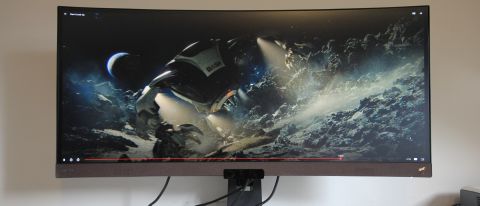TechRadar Verdict
The BenQ EW3880R is a great monitor for work and media consumption, but struggles with competitive gaming. It’s expensive, but for a casual computer consumer who spends hours in front of a screen, it could be compelling if they don’t demand high technical performance or are seeking to boost their work productivity.
Pros
- +
Huge desktop real estate
- +
Media looks great
- +
Excellent speakers
- +
Adjustable stand
Cons
- -
Struggles in fast games
- -
Pricey
- -
Average brightness and contrast
Why you can trust TechRadar
Two-minute review
We’ve seen some massive PC monitors launch in the last few years, but the BenQ EW3880R, with its 21:9 aspect ratio, is one of the widest and most interesting currently on offer. Its 38-inch (37.5-inch viewable) screen has great presence (before you even turn it on) with its subtle brown speaker grille and stand. It looks like something that would almost fit into a living room.
Sporting a 3,840 x 1,600 resolution, it’s capable of displaying a crisp and detailed Windows desktop and allows for four (count ’em) full-sized A4 windows to be placed next to one another. This can be a great productivity boon for those working with multiple documents, browsers and, especially, spreadsheets. However, we found that turning our head to look from one end of the screen to another could get a bit tiring on our neck. Still, there’s a subtle curve to the screen that reduces the amount your eyeballs need to refocus as they pan from side to side, and this helps with viewing comfort. There’s also BenQ’s TÜV Rheinland-certified anti-flicker and blue-light filter technology that's claimed to further prevent ocular fatigue. Ultimately, we loved working on this display, but it is one that's more designed for multimedia and productivity than gaming.
Our first thought, when looking at a screen this shape and size, is that it must be great for that latter use. However, while we were impressed with how the UHD graphics and textures of Far Cry 6 looked on the screen, the low 60Hz refresh rate quickly reminded us that this isn’t suitable for fast-paced action games and racers – if you're used to one of the newer high-refresh gaming displays, your eyes will very quickly complain about motion blur, image tearing and skipped frames.
Nonetheless, BenQ is keen to promote the video performance of the EW3880R and we were certainly impressed. The 10-bit IPS panel is great for watching movies, TV and video content generally – especially demo reels tailored for the panel's native resolution. Colors are bright and vibrant, while gradients (both chromatic and monochromatic) are smooth with no obvious stepping.
The 1,000:1 contrast ratio and 300-nit brightness rating are somewhat mediocre, however. Detail can get lost in particularly dark and bright areas. BenQ attempts to address this with its HDRi (simulated HDR) technology but, frankly, we found it more miss than hit – it could easily make images worse, and seldom improved matters. We’re being picky though, as most movie content generally looked great. Just note that you’ll usually have some form of letterbox bars near the sides of the screen as even supposedly native 21:9 content (of which there’s plenty on streaming sites like Netflix) doesn’t always fill the whole panel.
Also particularly noteworthy are the screen's built-in speakers. The large grille at the bottom helps hide two 3W speakers and an 8W sub. These are substantially superior specs compared to other multimedia monitors, and it shows – sound gets loud and punchy, vocal fidelity is great, bass is strong and treble stays clear. Very impressive.
The usual array of monitor adjustments (and connections) are available to tinker with, but we seldom strayed far from defaults. A remote is included too.
If it had a higher refresh rate for better gaming capabilities the EW3880R would frankly be brilliant, but even without it’s fantastic for work and play regardless. It’s expensive, but fairly priced in this 38-inch ultrawide space, and many cashed-up casual computer users will love it.
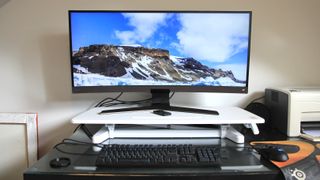
Price and availability
The BenQ EW3880R monitor is available now in most major markets and costs $1,050 / £1,030 / AU$1,799. While that's not cheap, it is one of the more affordable 38-inch ultrawides, and when compared to the likes of LG's similar 38WN95C (which costs significantly more at $1,750 / £1,350 / AU$2,199) or the Alienware AW3821DW ($1,950 / £1,565 / AU$2,499) the value proposition seems enhanced. Just note that the LG and Alienware are 144Hz displays, with faster pixel response time (1ms) and FreeSync and G-Sync compatibility, which make them more attractive for gaming.
Other alternatives include Dell's 21:9 monitors. While the U3821DW ($1,549 / £1,399 / AU$1,899) offers similar specs at a higher price, there's also an even-larger, 40-inch sibling (the U4021QW) at $2,099 / £2,049 / AU$2,639 for those who want the same aspect ratio and performance on an even-larger screen.
Design
The EW3880R’s panel is just about something that would fit in a modern, compact living room, thanks to the brown tinge on the speaker grille below the screen and on the stand. However, the stand does tend to scream that it’s still a computer monitor at heart, meaning it’s not quite suited to being the centerpiece of a family living room. However, having a computer monitor stand has its benefits. It comes with some generous adjustments including –5º to 15º tilt, –15º to 15º swivel and a 120mm height adjustment.
Accessing the input ports is relatively simple thanks to the large cutaway at the base of the display at the back (this can be covered with a removable panel). Just note that the power cord connects on the left-hand side, which may cause issues on your particular setup if all of your power sockets are on your right.
Setting it up is simple thanks to the three-piece design: stand, stem and panel. You’ll need the included hex key screwdriver and four screws to fix the panel to the stem though, as there’s no quick-release system.
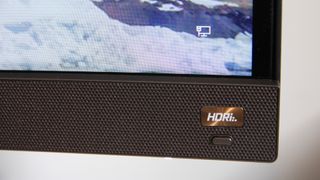
Features
BenQ makes a big fuss over its simulated HDR feature called HDRi. This can be activated via OSD controls, a button on the bottom right of the speaker grille or the included mini remote. It switches between three modes: Cinema HDRi, Game HDRi and HDR. With Windows HDR turned on, Cinema HDRi seems to delight by removing large, significant details and objects from the screen – especially in bright areas. Game HDRi aims to stop enemies hiding in shadows and highlights by reducing localized darkness and brightness through the compression of contrast range and it just about makes a difference.
The main HDR setting sits somewhere in between. Using HDRi with Windows HDR off leaves you with a blown-out mess in bright areas where it’s hard to see anything at all. In dark content, it could just as easily envelope everything in darkness. Individual experiences will vary with different content, but generally we felt it was a bit of a gimmick.
The remote itself is small and black, meaning you can easily lose it in a dark room. It operates responsively so long as you aim it directly at the IR receiver in the middle of the speaker grille. It has a directional button that emulates the mini directional control button at the right-rear of the screen, plus individual buttons for power, input, HDRi, night-mode volume (to protect from unexpected, late-night explosions and screams), volume controls and audio mode.
There’s also KVM functionality that allows you to plug your keyboard and mouse into the monitor and share their functionality – and screen input – via the USB-C connection. We’re big fans of this as lockdown has seen us regularly switch between home computer and work laptop, and simply swapping a USB-C cable can make switching more efficient.
BenQ also likes to highlight its eye comfort features. These include the subtle 2600R curve to help alleviate the strain caused by your eyeballs refocusing when looking at different parts of the monitor. There’s also TÜV Rheinland-certified anti-flicker technology and blue light filtering that, we acknowledge, helped ensure the screen was comfortable to look at for extended periods of work.
Connectivity
It can be a little tricky to reach the down-facing cables in the center of the rear of the monitor if your desk is set up in way that makes it hard to reach the back of the panel. Nonetheless, there are two HDMI 2.0 ports, DisplayPort 1.4, two downstream USB-A 3.0 ports and a USB-C port that supports DisplayPort and 60W power delivery.
HDMI and USB-C cables are included. Just remember that the latter is rather short so your PC or laptop must be close to the monitor.
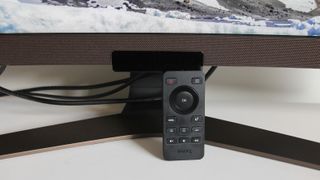
Performance
We loved working on the BenQ EW3880R. Its ability to display four, full-sized A4 documents (and then some), huge spreadsheets and large graphical working areas was a productivity dream – you rarely need to waste time and effort switching between windows, no matter what you’re doing. The Ultra HD 3,840 x 1,600 resolution kept everything crisp and in sharp relief. It’s evenly lit and all the eye comfort features, married with the matte screen, really meant that our eyes didn’t get fatigued after prolonged periods of work. Just note that if you’ve got any kind of neck injury, you may experience soreness by looking left and right more than you ordinarily would.
We were generally impressed with its multimedia prowess too. The IPS panel supports 95% of the challenging DCI-P3 color space for enhanced accuracy and we felt multimedia content looked above average in terms of motion smoothness and contrast. However, enthusiasts may lament the less-than-top-tier color vibrancy and brightness. Playing with the HDR settings in Windows and on the monitor can improve certain content types, but the results can quickly get away from you if there’s too much light or dark on screen, with it easily becoming hard to see anything. Still, we’re nitpicking a bit – video generally looked really good and there were smooth color (and monochromatic) transitions with minimal banding.
Naturally, you’re going to frequently see pillarboxing (aka reverse letterboxing) with video, as most TV shows and movies are not natively 21:9 formatted. We seriously appreciated the 21:9 content available on Netflix and Amazon, as it could take up the whole screen. However, you’ll find that many videos leave black bars to the sides of the screen, as they don’t stretch beyond a typical 16:9 widescreen resolution. Still, we were impressed at how the pillarbox bars, for the most part, stayed almost true black and weren’t too distracting.
We really wanted the EW3880R to work well for gaming, as the outlook isn’t far removed from a real-life cockpit in a race car. We didn’t mind that menus in games don’t support 21:9, although they can look a bit weird with pillarbox bars to the side. Cutscenes with actual letterbox bars at the top and bottom of the screen got a bit annoying, but they are relatively rare occurrences. Most importantly, using the entire screen for actual gameplay can be very immersive… especially when walking through the jungles of Far Cry 6.
The problems manifest when you get into gunfights or scenes with fast-and-frantic motion, as the 60Hz refresh rate and modest 4ms grey-to-grey pixel response time quickly show their limits – motion blur is rife, while dropping frames and image tearing happen in a way that many gamers have evolved past coping with. While we were generally happy with Far Cry 6's performance due to its general slow pace, if you’re planning on playing competitive shooters or racing games, you may want to step up to a monitor with gaming-grade refresh rates. That all said, flight sim players and strategy gamers who benefit from extra UHD real estate might just love it.
A special mention must be made of the speakers. There are two 3W units plus an 8W sub. These combine to produce some of the best audio we’ve heard from any monitor we've tested. Fidelity and clarity is good all the way from bass to treble, and they get impressively loud and punchy. There are a range of fairly-standard audio modes available for tinkering with, but everyone’s preferences will vary on those.
Should I buy the BenQ EW3880R?
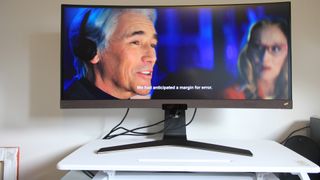
Buy it if...
You look at a screen all day for work
The massive, wide-screen, subtly curved, Ultra HD resolution and eye-comfort features mean that you can boost productivity all day long.
You want to watch movies in cinema widescreen format
With Netflix and Amazon offering an impressive amount of content in 21:9, you can enjoy movies as they were meant to be seen.
You want really good audio
The 2.1 sound system is seriously impressive and will suit those who don’t want to rely on additional speakers.
Don't buy it if...
You’re a competitive gamer
The 60Hz refresh rate and relatively slow 4ms response time means motion can blur relatively quickly and be uncomfortable to view.
You want real HDR
HDR can greatly enhance compatible content, but the simulated version here (married to mediocre brightness) is not the same.
You are prone to sore necks
You will be looking from left to right more than with a normal screen and this may cause issues if you’re doing it all day.
[First reviewed January 2022]
